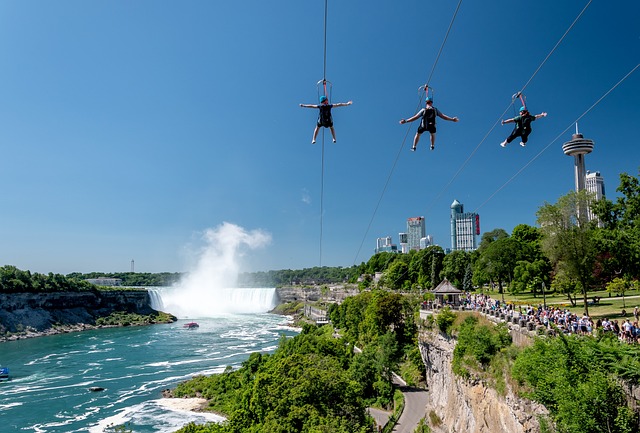Ziplining has become a popular adventure activity around the world, with enthusiasts seeking the thrill of soaring through the air at high speeds. However, with this excitement comes the need for safety measures, including an understanding of how ziplines stop.
Ziplines use various types of braking systems to slow down and stop the rider. There are two main categories of braking systems: passive and active. Passive braking systems rely on the natural forces of friction and gravity to slow down and stop the rider, while active braking systems require the rider to engage the braking system manually.
In this post, I will explore the mechanics of ziplines, and the various types of braking systems used to slow down and stop riders. I will also discuss the factors that affect stopping distance and important safety considerations for zipline operators and riders. By the end of this post, you will have a comprehensive understanding of how ziplines stop and how to ensure a safe and enjoyable ziplining experience. Let’s get started!
Overview of zipline mechanics
Before delving into how ziplines stop, it is important to understand the basic mechanics of a zipline. A typical zipline consists of a cable or rope that is strung between two points, often at a steep angle, creating a slope for riders to slide down. The cable is secured with anchors at each end, and the rider is attached to a trolley or pulley that runs along the cable.
As the rider descends down the cable, the force of gravity pulls them along the slope, increasing their speed. This is where the braking system comes into play, slowing the rider down and eventually bringing them to a stop. It is important to note that proper installation and maintenance of zipline components, such as the cable, anchors, and trolley, are crucial for safe operation.
Explanation of zipline components
To better understand the mechanics of ziplines, it is important to have a basic understanding of the components that make up a zipline.
- Cable: The cable is the main component of a zipline and is usually made of steel or synthetic materials such as Kevlar or nylon. It is attached to anchors at each end, creating a slope for riders to slide down. (Learn more about zipline cable here)
- Anchors: Anchors are used to securing the cable at each end and are typically anchored to strong, stationary structures such as trees, poles, or buildings. The anchors must be properly installed and regularly maintained to ensure the safety of the zipline.
- Trolley or pulley: The rider is attached to a trolley or pulley that runs along the cable, allowing them to slide down the slope. The trolley or pulley is equipped with a braking system to slow down and eventually stop the rider.
- Harness and safety equipment: The rider is typically secured to the trolley or pulley with a harness and other safety equipment such as a helmet and gloves to protect them from potential hazards.
- Braking system: As mentioned earlier, the braking system is essential to safely slowing down and stopping the rider. There are different types of braking systems, which will be discussed in more detail later in this post.
- Maintenance equipment: Zipline operators typically use maintenance equipment such as cables, ropes, and pulleys to regularly inspect and maintain the zipline components for safe operation.
How ziplines operate
Ziplines operate on the principles of gravity and friction. As a rider is released from the starting point, the force of gravity causes them to accelerate down the slope of the cable. The rider’s speed increases as they move further down the cable, and this is where the braking system comes into play.
The braking system is designed to slow down the rider and bring them to a safe stop at the end of the ride. Different types of braking systems use various mechanisms to create friction or resistance against the cable, slowing the rider down gradually.
Ziplines typically operate using one of two types of systems: a self-tending system or a manual system. In a self-tending system, the rider does not need to manually engage the braking system, as it is automatically triggered when they reach the end of the ride. In a manual system, the rider must engage the braking system by using a hand brake or pulling on a rope to slow down and stop themselves at the end of the ride.
Proper installation and maintenance of zipline components are crucial to ensure safe operation. The cable, anchors, trolley, and braking system must be inspected regularly and maintained to ensure they are functioning properly. Operators must also take into account external factors such as weather conditions, rider weight, and speed to ensure safe operation.
Importance of proper installation and maintenance
Proper installation and maintenance of zipline components are critical to ensuring the safety of riders. Ziplines operate under high stress and require careful attention to detail during installation to prevent accidents from occurring.
During installation, the cable must be properly anchored and tensioned to ensure it is secure and stable. The anchors must be inspected for strength and stability, and the cable must be tested for its weight capacity and structural integrity.
Regular maintenance is also essential to ensure the ongoing safety of the zipline. Maintenance tasks include regular inspection of the cable, anchors, and trolley to identify any signs of wear and tear or damage that could lead to failure. Regular lubrication of the cable, trolley, and braking system is also necessary to ensure smooth operation and prevent the system from seizing up.
In addition, zipline operators should establish a regular maintenance schedule and keep detailed records of maintenance activities performed on the zipline. By doing so, operators can ensure that all components are functioning properly, and any potential safety hazards are identified and addressed promptly.
Failure to install and maintain zipline components properly can result in serious accidents, including rider injuries or fatalities. Therefore, it is crucial to ensure proper installation and regular maintenance of zipline components to provide a safe and enjoyable experience for riders.
Types of zipline braking systems
There are various types of zipline braking systems, each with its own unique mechanism for slowing down and stopping the rider. The two main categories of braking systems are passive and active braking systems.
Passive braking systems
Passive braking systems rely on the natural forces of friction and gravity to slow down and stop the rider. There are three main types of passive braking systems:
- Gravity braking: This braking system relies on the slope of the cable to slow down the rider. The cable is installed at a steep angle, and the rider’s weight and the angle of the slope create friction that slows down the rider. This system is commonly used for shorter ziplines with a lower speed.
- Spring braking: In this system, a spring-loaded device is attached to the cable, and as the rider approaches the end of the ride, the spring compresses, creating friction that slows down the rider. This system is commonly used for longer ziplines, where the rider is moving at a higher speed.
- Friction braking: This system uses a braking mechanism that creates friction between the cable and the trolley to slow down and stop the rider. The friction is created by various means, such as rubber pads or metal plates, and is adjusted based on the rider’s weight and speed.
Active braking systems
Active braking systems require the rider to engage the braking system manually, either by using a hand brake or pulling on a rope. There are three main types of active braking systems:
- Hand-braking: In this system, the rider uses a hand-held brake to slow down and stop themselves at the end of the ride. The brake is applied by squeezing a lever or pulling a rope, creating friction that slows down the rider.
- Trolley-based braking: This system uses a mechanism attached to the trolley that engages the brake automatically when the rider reaches the end of the ride. This system is commonly used for longer and faster zip lines.
- Magnetic braking: This system uses a magnetic field to create resistance between the trolley and the cable, slowing down and stopping the rider. This system is commonly used in commercial ziplines and provides a smooth and controlled stop.
Operators must choose the appropriate braking system based on the length and speed of the zipline, as well as the level of rider experience. Proper training is also crucial to ensure that riders understand how to use the braking system effectively.
Factors affecting zipline stopping distance
Several factors can affect the stopping distance of a zipline, including:
- Weight of the rider: Heavier riders will travel faster and require a longer stopping distance compared to lighter riders.
- Speed of the rider: Riders who travel at higher speeds will require a longer stopping distance compared to those who travel at lower speeds.
- Slope of the zipline: The angle of the slope affects the speed of the rider and can increase the stopping distance.
- Type of braking system: Different types of braking systems have different stopping capabilities, and some may require a longer stopping distance than others.
Operators must consider these factors when installing and designing the zipline, as well as when choosing the appropriate braking system. Proper calculations and testing must be conducted to ensure that the stopping distance is adequate to ensure the safety of the rider. Operators must also take into account the rider’s weight and speed to ensure that the braking system is functioning effectively.
Safety Considerations for zipline braking systems
Ensuring the safety of riders is of utmost importance in zipline operations, and the braking system plays a crucial role in this. Here are some safety considerations for zipline braking systems:
- Regular inspections and maintenance: As mentioned earlier, regular inspections and maintenance are crucial to ensuring the proper functioning of the braking system. All components, including the cable, anchors, trolley, and braking system, must be inspected and maintained regularly to ensure they are functioning correctly and are free from wear and tear.
- Proper training of zipline operators: Zipline operators must receive comprehensive training on how to operate the braking system effectively, as well as how to respond to emergency situations.
- Use of appropriate personal protective equipment (PPE): Riders must wear appropriate PPE, such as a helmet and gloves, to protect them from potential hazards.
- Implementation of emergency procedures: Operators must have clear emergency procedures in place in case of an accident or malfunction of the braking system. Emergency procedures must be communicated to riders before the start of the ride and practiced regularly.
- Choosing the appropriate braking system: Operators must choose the appropriate braking system based on the length and speed of the zipline and the experience level of the rider. The braking system must be capable of providing a safe and controlled stop for the rider.
Conclusion
In conclusion, understanding how zip lines stop is crucial to ensuring the safety of riders. Ziplines operate on the principles of gravity and friction, with different types of braking systems used to slow down and stop the rider. Passive and active braking systems can be used, each with its own unique mechanism. Factors such as rider weight, speed, slope, and the type of braking system can affect the stopping distance of the zipline, and operators must take these into account when designing and installing the zipline.
Proper installation and maintenance of zipline components, including the cable, anchors, trolley, and braking system, are critical to ensuring safe operation. Operators must also provide appropriate training for zipline operators, implement emergency procedures, and choose the appropriate braking system based on the length and speed of the zipline and the experience level of the rider.
It is essential to prioritize safety in all aspects of zipline operations to prevent accidents and ensure the safety of all riders.









